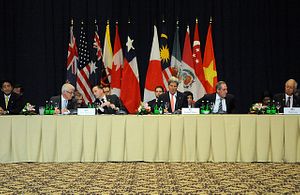While China has long stated that it is willing to consider joining the Trans-Pacific Partnership (TPP), it was not included in the agreement that was signed last week. The treaty includes 12 countries along the Pacific, with China conspicuously absent. However, it is not clear whether China considers this a snub, whether it plans to join the TPP in the future, or whether it is content to observe the execution of the agreement from the sidelines. Even the most seasoned China watchers have had difficulty interpreting what China’s reaction to the treaty may be.
The TPP reduces thousands of tariffs among the United States, Japan, Malaysia, Vietnam, Singapore, Brunei, Australia, New Zealand, Canada, Mexico, Chile and Peru. The agreement aims to maintain “high standards” on labor, environment, and intellectual property. Although the full text of the 1,500 page agreement has not been released, leaked excerpts reveal intellectual property rights extensively protect pharmaceutical patents, release information on copyright infringers, and set up environmental standards without enforcement mechanisms. This has disconcerted citizens’ groups and lawmakers alike and has generated some opposition to the treaty.
Although China is still able to join the TPP down the line, some analysts and politicians have stated that the trade agreement should provide a way for participating nations to offset China’s economic and trading power. Even U.S. President Barack Obama stated, ”When more than 95 percent of our potential customers live outside our borders, we can’t let countries like China write the rules of the global economy,” Obama said in a statement. “We should write those rules….” This statement provides fuel to long-held allegations that the TPP is being used by the U.S. to balance against China. Even if this is a reason for creation of the TPP, it is difficult to see how this type of comment will provide the Chinese leadership with confidence in joining the partnership in the future.
China was invited to join the TPP by Hillary Clinton in 2012. Some have speculated that China would not join the bloc because it is a “high standards agreement,” even speculating that this was put in place to lock China out of the agreement. However, it is not clear how these “high standards” will be enforced. Past trade agreements, such as NAFTA and CAFTA, with similar labor or environmental standards, have not been enforced by the United States. Whether the lack of enforcement renders more or less attractive to China is unclear. The benefits of the treaty may be attainable by China by creating separate free trade agreements with participating nations. Interestingly, Hillary Clinton herself has now come out against the pact due to concerns over aspects of the agreement, such as currency manipulation, that are insufficiently addressed.
China appears to currently have enough international economic negotiations on the table to keep it occupied, and it is unlikely that it is really concerned about the TPP. The nation is a sufficiently large player in the world economy to negotiate successfully with trading partners. China is already in the process of participating in the Silk Road project, the Asian Infrastructure Investment Bank, the New Development Bank, and other high-level economic structures. If the TPP proves valuable, perhaps China will join the alliance in the coming months. Hence it may prove beneficial if the treaty is not positioned as an anti-China agreement going forward.

































